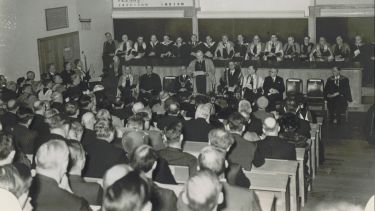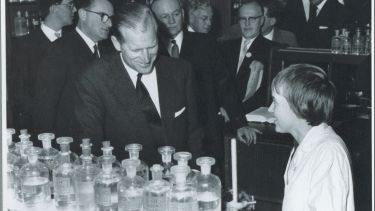History of the department
The Department of Chemistry has an extremely rich history which dates back over 100 years.

It's probably one of the most asked questions within the department. Everyone knows where lecture theatres 1 and 6 are, but where are the others? Did they ever exist, and where did they go? Mystery lecture theatres aside, the department's history is rich and fascinating. PhD student Zoe Smallwood delved into the history books to see how our department used to be.
The beginnings of the Dainton Building
Before the chemistry department was even formed, the University of Sheffield had to be established. In the late 1800's, there were several precursors to the University in the form of the Sheffield School of Medicine, Sheffield Technical School and Firth College, opened in 1828, 1884 and 1879, respectively. Firth College was founded and named after Mark Firth, the owner of a local steel business.
However, the situation at the School of Medicine was not good, and it faced closure. It was at this point that the city of Sheffield decided a university was needed, for the city to compete with others in the UK. The case was put forward to citizens in the form of a poster, asking people to contribute a penny towards the establishment of a new university for the city.
The people of Sheffield responded, and £50,000 later (approximately £15 million in today’s money) a campus was built on Western Bank for Arts, Science and Medicine. In 1905, the University of Sheffield was opened by King Edward VII and Queen Alexandra.
The Department of Chemistry was initially located a few hundred metres up the road from its current location, in the grounds of Firth Court (again named after Mark Firth, who founded Firth College). It was in no way the department we know today with chemicals being stored in air-raid shelters which had remained in the grounds following the World War II.
It was later decided that a new venue was needed for the chemists, so what is now called the Dainton Building (the grey/white part that houses the foyer of the building we know today) was built. This was opened in the 1950s by the Duke of Scarborough, in a ceremony that took place in lecture theatre one and covered by the Sheffield Star newspaper. The building was later named after Frederick Dainton, a chemist who was the Chancellor of the University between 1978-1997.
Dainton Building renovations
The Dainton Building has continued to evolve over the past seventy years. The main centre block was quickly added to in subsequent years.
First the East Wing was built, in 1961, followed by the West Wing, (also known as the Haworth Wing) in 1964, which is the section of the department that backs onto the Arts Tower car park. The North Wing, also known as the Beaumont wing, quickly followed in the 1968. This block now contains the undergraduate teaching laboratories. As can be seen in picture 3, construction was not subject to the health and safety regulations we know of today.
The East Wing housed a library (where the entrance to the academic corridor is now), teaching labs and some research labs at the very end of the building, as well as some lecture theatres. The East Wing was host to a visit from the Duke of Edinburgh in 1971, whose visit resulted in crowds of people on the stairwell to try and get a glimpse of royalty.
In 2005 the East Wing underwent an extensive refurbishment. During this time, the teaching labs were moved to their current position in the North Wing, and the Richard Roberts Auditorium replaced the smaller lecture theatres. In addition, the East Wing was renamed after Richard Roberts, a Nobel Prize-winning chemist who studied for his undergraduate degree and PhD in the department.
A family connection
One of our own technicians, Stephen Atkin, has a family connection to the department: his grandfather George Dodsworth worked here for a year on an apprenticeship in the 1940s. He recalls the department being located in Firth Court before its move to the current site in 1954, with the chemicals being stored in the air-raid shelters which remained in the grounds following the war. He has kindly drawn us a floor plan (below) of the old department, which shows a very different setup to the one we have now.
Standard safety equipment such as goggles and lab coats were never worn in those days, with labs arranged around long wooden benches with no fume hoods. He also recalls a chain smoking organic chemistry professor, who was never seen without a cigarette.
Where were lecture theatres 2-5?
Lecture theatres 3 and 4 were located on D and E floor, directly above lecture theatre 1, where research labs and write up rooms now exist. Lecture theatre 4 overlooked one of the research labs on E floor, which proved particularly useful when a fire broke out in a neighbouring lab in the 1990s. Two lecturers, attending a seminar at the time, noticed what was going on and quickly scrambled out of their seats to extinguish the fire, thankfully before any major damage or injury was caused.
Lecture theatres 2 and 5 were located in the old East Wing, on A floor (which is now the bottom of the Richard Roberts Auditorium) and D floor respectively, and were removed when the building was refurbished to become the Richard Roberts building in 2005. When they were removed, it was decided that changing the names of the remaining two would cause too much confusion, so lecture theatre 6 retained its name.
The departmental community
Although the first female academic appointments would not take place until almost half a century later, during the First World War many female chemists were recruited to replace the men who were called up to serve. A team of Sheffield chemists were responsible for synthesising eucaine, a then-novel anaesthetic. The team's contributions often resulted in appointments as technical and teaching assistants once the war had ended.
As the building has changed over the years, so has the community itself. The department used to have segregated toilets for staff and students, postgraduates had their own common room in the East Wing, and the University Arms pub was a place where students were only permitted to enter if they were in the company of a member of staff.
The appointment of the department’s first female academic was in 1995 (our very own Professor Jane Grasby). Nowadays, the department is the proud holder of an Athena SWAN Silver Award for commitment to equality in science and the University Arms is open to all.
Staff numbers and their duties have also changed. In the 1970's, there were approximately 70 technical staff, whose duties used to include picking up items from stores that researchers had ordered. This number has declined over the years to approximately 30 today, with the job of picking up items from stores now handed over to researchers.

